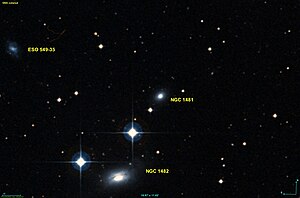NGC 1481
| Galaxy NGC 1481 |
|
|---|---|

|
|
| AladinLite | |
| Constellation | Eridanus |
|
Position equinox : J2000.0 , epoch : J2000.0 |
|
| Right ascension | 03 h 54 m 28.9 s |
| declination | -20 ° 25 ′ 38 ″ |
| Appearance | |
| Morphological type | SA0-: / HII |
| Brightness (visual) | 13.8 mag |
| Brightness (B-band) | 14.8 mag |
| Angular expansion | 1 ′ × 0.7 ′ |
| Position angle | 133 ° |
| Surface brightness | 13.5 mag / arcmin² |
| Physical data | |
| Redshift | 0.006026 (± 0.000025) |
| Radial velocity | 1807 (± 7) km / s |
|
Stroke distance v rad / H 0 |
(76 ± 5) · 10 6 ly (23.4 ± 1.6) Mpc |
| history | |
| discovery | John Herschel |
| Discovery date | November 13, 1835 |
| Catalog names | |
| NGC 1481 • PGC 14079 • ESO 549-032 • MCG -03-10-053 • IRAS F03522-2034 • 2MASX J03542901-2025380 • SGC 35217-2034.4 • | |
NGC 1481 is an elliptical galaxy with extensive star formation regions of the Hubble type E / S0 in the constellation Eridanus in the southern sky . It is estimated to be 68 million light years from the Milky Way and about 20,000 light years across . It probably forms a gravitationally bound galaxy pair with NGC 1482 .
The object was discovered by John Herschel on November 13, 1835 .
